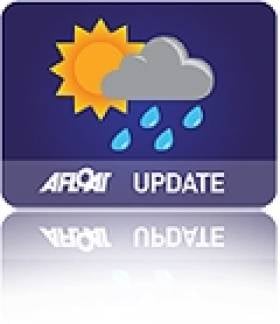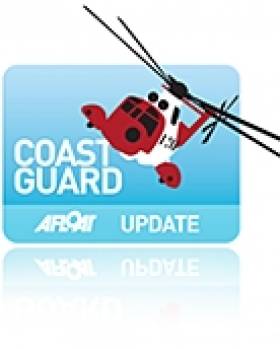Displaying items by tag: apps
A new smartphone app aims to provide sea swimmers with all the details they need before taking a dip and more.
The Sea uses your device’s geolocation capabilities to provide tailored information on tide times, water temperature, wave height and wind seed.
It also highlights local activities of interest, and features related podcasts, blogs and advocacy on ocean health and much more besides.
App developer and experienced sea swimmer Peter O’Brien recently joined Bobby Kerr on his Newstalk show Down to Business to discuss the inspiration behind the app and his hopes for it as a resource for “the sea lovers of the island”.
ISA SafeTrx System Paused For Upgrade Tomorrow
#SafeTrx - Users of the ISA's SafeTrx app are advices that the system will be unavailable tomorrow morning and afternoon (Tuesday 15 September) for an upgrade.
During the planned upgrade from 6am to 3pm, the SafeTrx apps for iOS and Android, as well as the ISA SafeTrx Boater website, will be unavailable.
Following the upgrade, a new version of the app will be available to download for your smartphone, with older versions no longer functioning after tomorrow.
CoastalBoating.net details the changes boaters can expect from the updated SafeTrx app, including a new emergency call feature.
New Sailing Tracker App 'Will Save Many Lives'
#Apps - A new smartphone app developed by the Irish Sailing Association (ISA) that aims to make it easy for boaters to allow contacts on shore to monitor their voyages has been launched today (Thursday 22 August).
Marine Minister Simon Coveney was on hand in Cork for the official unveiling of ISA SafeTrx, which was developed in association with the Irish Coast Guard and DeCare Systems Ireland.
The SafeTrx app is available free for iOS and Android powered smartphones and tablets, and lets boat owners log their voyages directly into their device - allowing them to be tracked by their chosen contacts, including the Irish Coast Guard.
It's also expected that the app will also help the coastguard to identify the location of a stricken vessel, and assess details such as craft description, contact details ashore, previous activity, where the boat was last visible to the network and where headed, persons on board and other information - all targeted at reducing the time that seafarers spend in the water waiting for a lifeboat or helicopter.
“SafeTrx helps take the search out of search and rescue," said Irish Coast Guard director Chris Reynolds. "It encourages all sea users to plan and execute their trips better, safer and gives assurance to friends and partners ashore.”
His comments were echoed by ISA chief executive Harry Hermon, who said: "I believe that ISA SafeTrx, which has been designed by coastguard professionals and built right here in Cork, will help to reduce the number of fatalities on the water even further. I have no doubt that this will save many lives."
Also speaking at the launch today, Minister Coveney said: “The concept of safety at sea and on our network of rivers and lakes must become as commonplace as that of safety on our roads. We need to create a culture of safety first for those travelling on our waters for either commercial or recreational reasons.
"With loss of life continuing across the maritime spectrum, those who make their living from the sea and those who utilise the sea primarily for leisure purposes must ensure that safety becomes a top priority.”
ISA SafeTrx logs position reports every kilometre (or every 5 minutes if stationary). Should the user fail to return on time, their emergency contacts will be automatically alerted via SMS and advised to initiate the appropriate action.
Voyage position reports are displayed on the SafeTrx Monitoring Console so when an emergency contact calls the Irish Coast Guard concerning an overdue trip, coastguard staff will have access to the user’s location and SafeTrx trip data through a secure SafeTrx server. And as the ISA SafeTrx app periodically sends location data back to the servers, the coastguard's response team can get help directly and quickly.
However, an expert in GPS technology has warned boat users against relying solely on such apps when heading out on the water.
Writing for Afloat.ie's Have Your Say blog, Gary Delaney of Global Position Intelligence (GPI) says the GSM and GPRS location technology on which the SafeTrx app is based is "less than reliable" in Irish coastal and nearshore waters, and "can deteriorate with the weather".
"It is well recognised that in the event of a maritime emergency, lifesaving agencies need to know the current position of the casualty as quickly as possible," he writes. "An assessment of available technologies reveals that only normally approved safety communications devices, such as marine VHF, AIS, EPIRBs, PLBs, ELT, etc can come near guaranteeing that requirement."
The app developers have acknowledged such concerns, saying that ISA SafeTrx is "not intended to be used as a replacement for statutorily recognised safety devices" but is "a resource that in some instances may help to raise an alarm earlier and assist emergency services to locate casualties more accurately".
As always, Afloat.ie advises boaters and sailors to stick to a standard safety checklist, which includes informing a contact on shore of your plans and expected return time, and confirming that you have adequate means for calling for help - from a suitable VHF radio to flares for signalling distress.
New Sailing App Calls For Note of Caution
In our latest Have Your Say contribution, Gary Delaney of Global Position Intelligence (GPI) expresses his concerns about the new ISA sailing app and how it might encourage boat users to be less prepared on the water
With regard to the recent marketing for the new ISA SafeTrx smartphone app, I wish to add a note of caution to those who might consider using it.
Whilst it may well be very useful as a passage plan filing tool, the element of the app which concerns itself with tracking a vessel should NOT be relied upon as it depends solely on mobile phone coverage.
It is widely known that the mobile phone coverage in Irish coastal and nearshore waters is less than reliable (and can deteriorate with the weather) and international maritime safety organisations routinely warn against reliance on mobile phones for communications in those areas.
I am sure that the Irish Coast Guard had originally intended that warnings would be associated with the marketing of the app for this purpose, but the nature of apps and social media is such that they are normally not used for promoting safety critical solutions, and therefore warnings may be getting lost in the promulgation.
In short, neither smartphones nor the GSM/GPRS network that supports them are reliable for any aspect of maritime safety, and there are more suitable technologies already available for the purpose.
As international maritime safety organisations do not normally recommend the use of mobile phone technology for any aspect of marine safety, the Irish Coast Guard must have significant justifications for deviating from this long established policy, and it would be useful if these were stated.
Similarly, it would also be useful to know if this initiative is being supported by the Irish Marine Safety Working Group in the Department of Transport, which has responsibility in this area.
It is well recognised that in the event of a maritime emergency, lifesaving agencies need to know the current position of the casualty as quickly as possible. An assessment of available technologies reveals that only normally approved safety communications devices, such as marine VHF, AIS, EPIRBs, PLBs, ELT, etc can come near guaranteeing that requirement.
These devices have gone through years of global development, advancement, testing and approvals for the purpose in a marine environment and, therefore, only these can be relied upon to minimise the 'search' element of the 'search and rescue' effort – and thereby give casualties the best chance of survival.
Whilst the ISA SafeTrx app may be aimed at those who under current legislation are not required to carry any of the approved devices, I feel that life saving agencies are better served by raising awareness about what is approved and encouraging water users to use them voluntarily anyhow, rather than confusing the message by emphasising the 'tracking' element of the app.
The fact that the app is free (airtime costs excluded), and the approved technologies are not (though very affordable, especially when personal safety is the prize), further confuses the message.
And the RNLI, who have been rescuing people on our coastline for hundreds of years, are very clear that marine VHF is to be preferred over mobile phones in all cases (their website confirms this).
There has been much poorly informed comment in popular media about the SafeTrx app. One comment alleges that the app is particularly suited to "weekend and leisure crews who may prefer more accessible and less sophisticated communication equipment".
But it is not about what is 'preferred', and this and other similar comments are misleading and potentially dangerous, The Irish Coast Guard and the Irish Sailing Association should consider taking action to correct them and ensure suitable warnings are publicly communicated wherever the app is being promoted.
To the best of my knowledge, the Irish Coast Guard has no role in the development, testing or approval of marine safety equipment. Therefore, whatever investment or effort has gone into supporting this app may well have been better spent serving the coastguard's role of raising public awareness around the availability and use of approved marine safety equipment, including the radio and communications devices that are available for use in Irish waters – most likely in co-operation with its other partner agencies in the Irish Marine Safety Working Group.
For my own part, I strongly suggest that water users in coastal areas would use common sense when it comes to their personal safety by investing in approved technologies whether they have to or not and get themselves properly trained to use them.
If using the SafeTrx App, then do so with considerable caution – only as an addition to the approved devices, and then primarily just for filing passage plans.
New Smartphone Apps For Smart Sailing
#SailingApps - Two new smartphone apps are just the ticket for anyone looking for an easy-to-use reference guide while out on the water as this summer's sailing season gets into full swing.
Safe Skipper - for iOS and Android devices priced €2.69 (with a free version also available) - touts itself as an "essential quick reference" app intended for everyone who goes to sea, whether sailing or in powerboats.
The app is divided into three main sections. The 'preparation' section includes details and tips on doing engine and rigging checks, overboard drills and weather and tidal updates. The 'safety' section covers necessary equipment from anchors to flotation aids, and communications guides on AIS, VHF radio and even Morse code.
Finally, the 'distress and emergencies' section details plans of action in the event of dismasting, engine failure or fire, medical emergencies and abandoning ship.
Safe Skipper is illustrated by RYA qualified yachtsman Simon Jollands, providing clear instructions for whatever issue you might have while afloat.
Meanwhile, SailingApp (for iPhone, priced €5.49) is "built from the water up for sailors by sailors".
The dual-function app is split between tools - allowing sailors to make on-the-fly calculations and checks for such things as anchor rode - and topics essential for good seamanship practices available with a single click.
Users who download SailingApp before 31 May will also receive any future updates to the app free of charge.
Smartphone App Helps Boat Lost in Fog
#Smartphone - A yacht managed to avoid collision with a container ship off the coast of South Africa recently - thanks to a smartphone app.
As Yachting Monthly reports, Ian Engelbrecht and crew Ibolya Palko were delivering a catamaran from Cape Town to Durban when they were trapped in thick fog not far the coastline.
When their primary AIS system stopped working, Engelbrecht turned on a smartphone app called Boat Beacon as a way to alert them to any other ships in the vicinity.
The app did its job, alerting the pair to a container vessel travelling in the opposite direction, though they were unsure of what corrective action to take due to the poor visibility and not knowing the closest point of approach (CPA).
Despite this, collision was averted - and the incident has prompted the app developers to add a CPA bearing feature to their product.
Yachting Monthly has more on the story HERE.
Met Éireann Launches New iPhone Weather Update App
#Weather - Met Éireann has developed a new smartphone app providing up-to-date weather forecasts for those on the go - especially on the water.
The new app features the latest reports, radar information and satellite imagery with both local and provincial forecasts, with specific forecasts tailored to Ireland's sea area and inland lakes, coastal reports and ferry crossings as well as Atlantic charts.
Users can also adapt the app preferences for their specific location and needs, whether you're aiming to go boating in our inland waterways or go fishing off the coast.
The Met Éireann app is now on iTunes to download for the iPhone, and an Android version is also available.
Irish Coast Guard's New Smartphone App Aims to Save Lives
#COASTGUARD - A new smartphone app from the Irish Coast Guard could save dozens of lives, as the Irish Independent reports.
The new technology allows the coastguard to track vessels at sea, and automatically prompts a search and rescue effort if they do to return to port as expected.
"The whole idea is to encourage mariners to inform us when they are going out to sea," said Malin Head district commander Derek Flannery. "When and where they plan to go, when they plan to return and how many are going."
It is hoped that the new app will encourage seagoers to me more conscious of altering emergency services to their movements, in the wake of very recent tragedies off Spanish Point in Co Clare and the Beara Peninsula in West Cork.
They system works by asking mariners to input details about their excursions - such as destination and expected return time - into the app before they set off. The app will also track the vessel's movements via GPS.
"We'll text the boater to remind them to check in but if we don't get a response we can send out a crew," added Flanagan.
According to TheJournal.ie, the iPhone-only app is currently being trialled by sailors, divers, fishermen, powerboaters and pleasurecraft users throughout Ireland, and there are plans to develop the app for a range of smartphones.
“Getting to casualties early is the key for our search and rescue units," said Dublin Bay North TD Seán Kenny. "This new app has the potential to get our resources on-scene as quickly as possible which will in turn save lives.”
Free Mobile App for Visitors to Volvo Ocean Race Galway
#VOLVO OCEAN RACE - Silicon Republic reports that researchers at NUI Galway have created a free mobile app for visitors to the city during the Volvo Ocean Race festivities starting this weekend.
Graduate students at the university's Digital Enterprise Research Institute (DERI) developed the app to provide visitors with up-to-date details of the festival programme from 30 June to 8 July - such as the slipway locations and dock gate opening times - as well as handy hints and tips for making the most of the City of the Tribes.
The DERI team have also integrated some of their own social technologies into the app such as 'Connect and Chat' and 'Tweet Cliques' so users can connect with their friends in the city.
The Volvo Ocean Race Festival Galway app is available from Apple's App Store and from the Google Play store for Android devices.
Silicon Republic has more on the story HERE.
New App Shows the Racing Rules
American firm DP Associates has announced the launch of You-Tack! Pro, The Racing Sailor’s Illustrated Guide. Easily understood, it has extraordinary 3D animated quizzes and brilliant illustrations. You-Tack! Pro is available at the iTunes Store for $19.95. (You-Tack! Lite, a free demo, highlighting the major features, is also available – on the iTunes Store by 06/30).
Major Features:The Official ISAF Rules and Definitions with colorful clear illustrations, simple, direct explanations and hyperlinked citations, that make the rules easy to understand. Included for quick reference are all the rules from Part 1 through Part 7, with the appendices A thru D.Forty-two quizzes with vivid “you are there” 3D animations, in seven distinct categories: The Start, Sailing Upwind, The Upwind Mark, Sailing Downwind, The Downwind Mark, The Finish, and Signals.
Each quiz contains: a fact-based Situation, an Illustrated Question, and a 3D Animation. Answer the quiz to find out if you’re right, and review the rationale behind the answer, while a Scoreboard tracks all your answers, and points you to a list of the rules you missed.After completing a quiz, the specific rules and definitions discussed in each quiz are displayed for review.All the racing signals are explained in detail with brilliant graphics, including images of all the international signal flags.No other Racing Rules app comes close!
You-Tack! Pro could be used as a teaching tool for junior programs (run it on the iPod), and a fun clubhouse method for crews looking to build rules knowledge. You-Tack! Pro makes learning the Racing Rules of Sailing easy, and fun. Created by racing sailors for racing sailors, whether the boat you sail is a maxi-yacht, a beer-can racer or a one-design dinghy, You-Tack! Pro is the quickest and most convenient way to build racing confidence, with increased rules knowledge.
To purchase You-Tack! Pro, or to download the demo, You-Tack! Lite, please visit the iTunes App Store.
It highlights and examples the features and functionality of You-Tack! Pro - including a fully indexed listing of all the rules, (displaying the specific details, illustrations and explanations of Rules 1 to 13). Featured are two 3D animated quizzes, all the signals, and all the definitions. It’s a free and easy way to see how the quizzes and the 3D animations function, and how the rules are illustrated in the Pro version.
More on: [email protected], 212-941-1441, or 917-417-3728































































